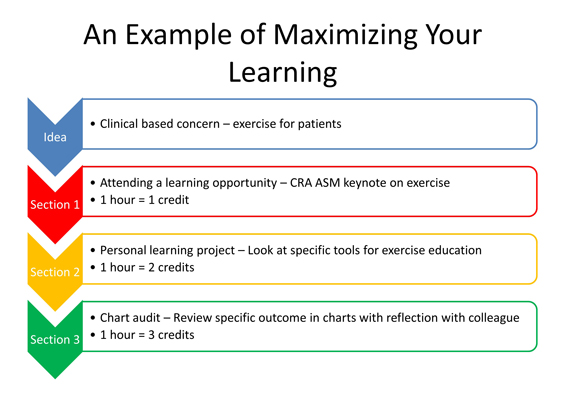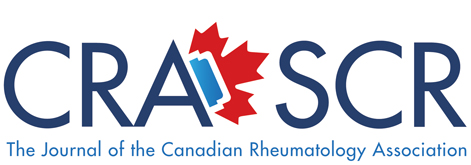Summer 2017 (Volume 27, Number 2)
CPD for the Busy Rheumatologist:
What Makes a Good Trilogy: Maximizing Your Learning
and Building Your MOC Credits
By Raheem B. Kherani, BSc (Pharm), MD, FRCPC, MHPE; Jerry M. Maniate, MD, M. Ed, FRCPC;
and Craig M. Campbell, MD, FRCPC
Download PDF
Section 1
Do you remember the sessions you went to at the 2017 CRA Annual Scientific Meeting (ASM) in Ottawa? Reflecting over the past few months, you enjoyed meeting colleagues in February, and even got a chance to skate on the canal during Winterlude festivities! That opening keynote talk by Dr. Jonathon Fowles on “Exercise is Medicine” was meaningful in what to do to help patients progress further in engaging with exercise. At the time, you thought about the fact that you have often suggested exercise, but patients have come back and said it is too difficult, or they do not have sufficient time. Because of these reflections at the conference, you may have tried to see if there was room in his workshop so that you could apply this further and learn more about practical ways to implement prescribing exercises for individual patients. All these learning activities qualify for Maintenance of Certification (MOC) Section 1 credits (www.royalcollege.ca/rcsite/cpd/moc-program/moc-framework-e) (1 hour =1 credit).
Section 2
Over the months since the ASM, you have seen several patients in your clinical practice that would benefit from simple exercises. These patient interactions may have stimulated you to ask what specific tools or strategies are effective in promoting patients to engage in exercise. As part of this learning project, you may have reviewed the Exercise is Medicine website (http://exerciseismedicine.org/canada/) and some of the tools for patients – specific strategies to prescribe exercise, handouts for patients and videos on teaching simple resistance band exercises. Based on this material, you decided how you would use these tools for patients who would benefit from exercise. This is a personal learning project which qualifies for MOC Section 2 credits (www.royalcollege.ca/rcsite/cpd/moc-program/moc-framework-e) (1 hour = 2 credits). And, there is more…
Section 3
At the end of a busy day in clinic, you sit back and wonder if prescribing exercise helps patients? There is evidence that it certainly helps patients. But what you are wondering is – does it help my patients? Can I help other similar patients? This stimulates exploration through a chart audit. After reviewing the Royal College guidelines on clinical audit (www.royalcollege.ca/rcsite/documents/continuing.../clinical-audit-guidelines-e.pdf), you decide to review the last 10 patients for whom you have prescribed exercise to find out how such a prescription has improved their functional status (with a Patient Global Score or a Health Assessment Questionnaire [HAQ]) three months later. Some patients did not comment on any benefit, or at least it was not noted in your chart notes. Some patients reported a 20 to 30 point improvement in their Patient Global Score (out of 100)! You review these findings with a colleague, who gives you feedback and stimulates your reflection on how prescribing exercise is currently helping patients and ways in which these prescriptions can be enhanced to help your patients even further. The time spent on this clinical chart audit that incorporate feedback and reflection with a colleague, qualifies for MOC Section 3 credits (www.royalcollege.ca/rcsite/cpd/moc-program/moc-framework-e) (1 hour = 3 credits).
Looking back, all these learning activities were stimulated by the one-hour keynote session you attended in Ottawa in February, all the while furthering the care of your patients!
Sequential learning with multiple activities from different MOC sections helps translate knowledge from theory into practice, while evaluating its impact on patient outcomes. We all have busy lives with competing personal and professional interests. This utilization of a single educational session can indeed result in a good trilogy, not only for your MOC Program participation, but also for your personal development and enhancement of patient care. For more questions about the MOC Program, please consult the Royal College's web pages on Continuing Professional Development (CPD) activities (www.royalcollege.ca/rcsite/cpd/moc-program/cpd-activities-can-record-e) and FAQs. If you have stories or tips to share, please email Claire McGowan at claire@rheum.ca.

Acknowledgement: To Dr. Barry Koehler (former CRA Past-President), for the initial discussion that lead to this article, immediately following the 2017 CRA ASM.
Raheem B. Kherani, BSc (Pharm), MD, FRCPC, MHPE
CRA Education Committee Chair
Clinical Associate Professor, University of British Columbia
Medical Lead, Arthritis Program,
GF Strong Rehabilitation Centre
Vancouver, British Columbia
Rheumatologist,
West Coast Rheumatology Associates
Richmond, British Columbia
Jerry M. Maniate, MD, M. Ed, FRCPC
Chief,
Medical Education, Research and Scholarship
St. Joseph's Health Centre
Assistant Director of Researchers, Wilson Centre,
University of Toronto
Toronto, Ontario
Craig M. Campbell, MD, FRCPC
Director,
Continuing Professional Development,
The Royal College of Physicians and Surgeons of Canada
Ottawa, Ontario
|




